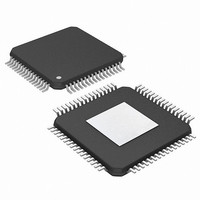PIC24FJ256DA210T-I/BG Microchip Technology, PIC24FJ256DA210T-I/BG Datasheet - Page 241

PIC24FJ256DA210T-I/BG
Manufacturer Part Number
PIC24FJ256DA210T-I/BG
Description
16-bit, 256KB Flash, 96K RAM, USB, Graphics 121 XBGA 10x10x1.20mm T/R
Manufacturer
Microchip Technology
Series
PIC® 24Fr
Specifications of PIC24FJ256DA210T-I/BG
Core Processor
PIC
Core Size
16-Bit
Speed
32MHz
Connectivity
I²C, IrDA, SPI, UART/USART, USB OTG
Peripherals
Brown-out Detect/Reset, GFX, LVD, POR, PWM, WDT
Number Of I /o
84
Program Memory Size
256KB (85.5K x 24)
Program Memory Type
FLASH
Ram Size
96K x 8
Voltage - Supply (vcc/vdd)
2.2 V ~ 3.6 V
Data Converters
A/D 24x10b
Oscillator Type
Internal
Operating Temperature
-40°C ~ 85°C
Package / Case
121-TFBGA
Lead Free Status / RoHS Status
Lead free / RoHS Compliant
Eeprom Size
-
Lead Free Status / RoHS Status
Lead free / RoHS Compliant
Available stocks
Company
Part Number
Manufacturer
Quantity
Price
Company:
Part Number:
PIC24FJ256DA210T-I/BG
Manufacturer:
Microchip Technology
Quantity:
10 000
- Current page: 241 of 408
- Download datasheet (4Mb)
2010 Microchip Technology Inc.
18.1
18.1.1
18.1.1.1
PIC24FJ256DA210 family devices have a built-in
1.5 k resistor on the D+ line that is available when the
microcontroller is operating in Device mode. This is
used to signal an external Host that the device is
operating in Full-Speed Device mode. It is engaged by
setting the USBEN bit (U1CON<0>). If the OTGEN bit
(U1OTGCON<2>) is set, then the D+ pull-up is enabled
through the DPPULUP bit (U1OTGCON<7>).
Alternatively, an external resistor may be used on D+,
as shown in Figure 18-2.
FIGURE 18-2:
18.1.1.2
Many USB applications will likely have several different
sets of power requirements and configuration. The
most common power modes encountered are:
• Bus Power Only mode
• Self-Power Only mode
• Dual Power with Self-Power Dominance
Bus Power Only mode (Figure 18-3) is effectively the
simplest method. All power for the application is drawn
from the USB.
To meet the inrush current requirements of the USB 2.0
Specification, the total effective capacitance appearing
across V
In the USB Suspend mode, devices must consume no
more than 2.5 mA from the 5V V
cable. During the USB Suspend mode, the D+ or D-
pull-up resistor must remain active, which will consume
some of the allowed suspend current.
In Self-Power Only mode (Figure 18-4), the USB
application provides its own power, with very little
power being pulled from the USB. Note that an attach
indication is added to indicate when the USB has been
connected and the host is actively powering V
PIC
BUS
Hardware Configuration
®
DEVICE MODE
MCU
and ground must be no more than 10 F.
D+ Pull-up Resistor
Power Modes
V
USB
D+
D-
EXTERNAL PULL-UP FOR
FULL-SPEED DEVICE
MODE
1.5 k
BUS
Controller/HUB
line of the USB
Host
BUS
PIC24FJ256DA210 FAMILY
.
To meet compliance specifications, the USB module
(and the D+ or D- pull-up resistor) should not be enabled
until the host actively drives V
tolerant I/O pins may be used for this purpose.
The application should never source any current onto
the 5V V
The Dual Power mode with Self-Power Dominance
(Figure 18-5) allows the application to use internal
power primarily, but switch to power from the USB
when no internal power is available. Dual power
devices must also meet all of the special requirements
for inrush current and Suspend mode current previ-
ously described, and must not enable the USB module
until V
FIGURE 18-3:
FIGURE 18-4:
FIGURE 18-5:
V
V
~3.3V
V
V
~3.3V
~5V
BUS
~5V
SELF
BUS
SELF
V
~5V
100 k
BUS
BUS
BUS
Regulator
Low I
Low I
is driven high.
100 k
pin of the USB cable.
Q
Q
Regulator
3.3V
100
100
100
3.3V
BUS POWER ONLY
SELF-POWER ONLY
DUAL POWER EXAMPLE
Attach Sense
BUS
Attach Sense
Attach Sense
high. One of the 5.5V
DS39969B-page 241
V
V
V
V
USB
BUS
DD
SS
V
V
V
V
V
V
V
V
BUS
DD
USB
SS
USB
BUS
DD
SS
Related parts for PIC24FJ256DA210T-I/BG
Image
Part Number
Description
Manufacturer
Datasheet
Request
R

Part Number:
Description:
Manufacturer:
Microchip Technology Inc.
Datasheet:

Part Number:
Description:
Manufacturer:
Microchip Technology Inc.
Datasheet:

Part Number:
Description:
Manufacturer:
Microchip Technology Inc.
Datasheet:

Part Number:
Description:
Manufacturer:
Microchip Technology Inc.
Datasheet:

Part Number:
Description:
Manufacturer:
Microchip Technology Inc.
Datasheet:

Part Number:
Description:
Manufacturer:
Microchip Technology Inc.
Datasheet:

Part Number:
Description:
Manufacturer:
Microchip Technology Inc.
Datasheet:

Part Number:
Description:
Manufacturer:
Microchip Technology Inc.
Datasheet:











